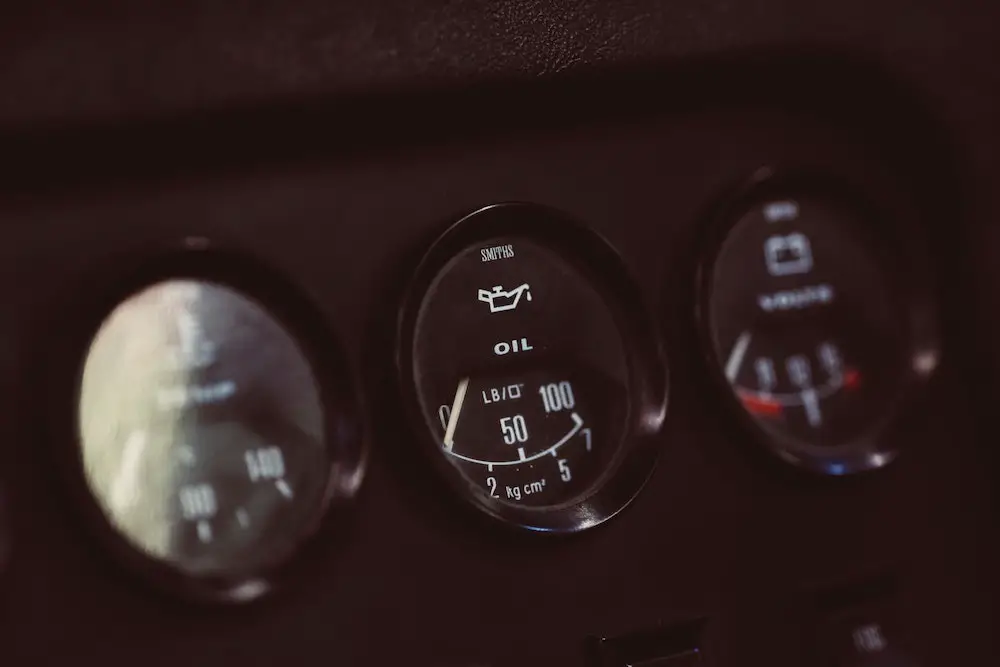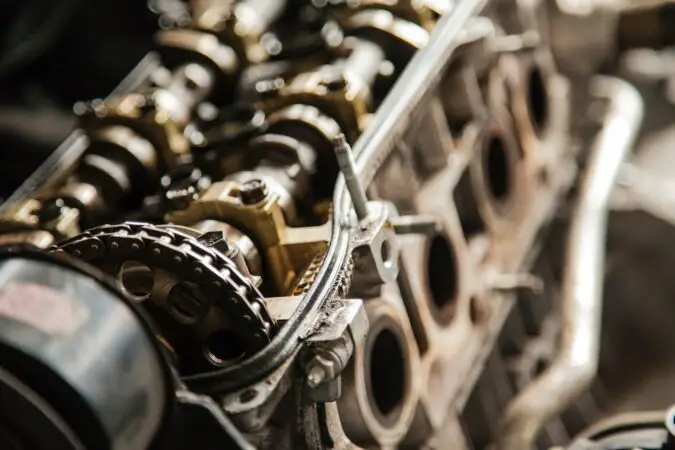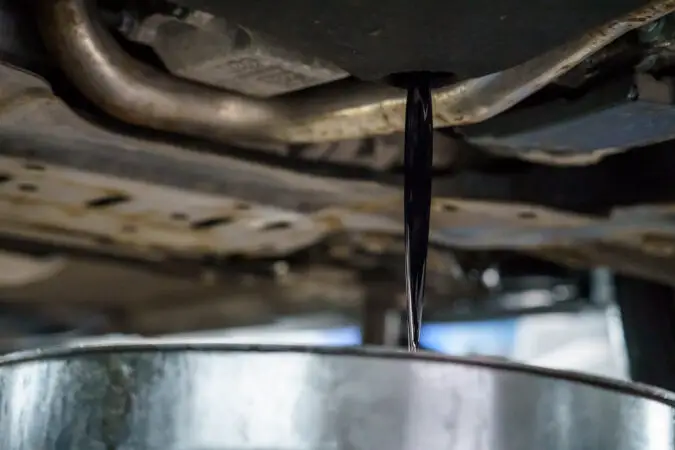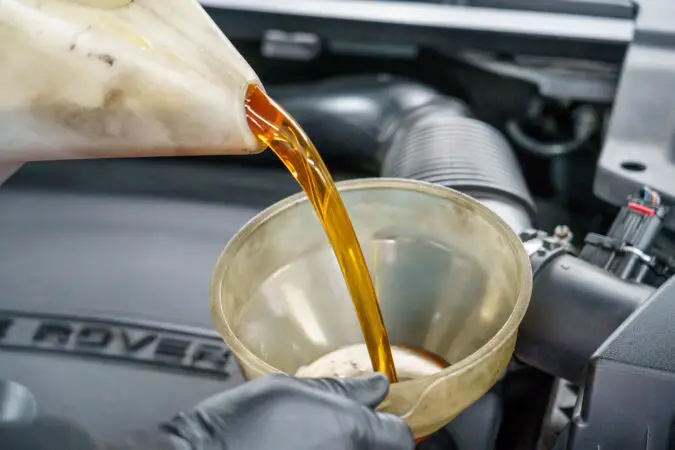Engine oil is what fuels engines and is thus an essential element of a vehicle. Modern engines last longer than engines of the past thanks to the higher oil pressure. On your dashboard, you will see an oil pressure light which is used to notify the driver if the oil pressure of a vehicle is too high or too low.
No oil pressure or very low oil pressure can slowly eat away at your car’s engine. Therefore, it’s important to not avoid this light if you ever see it in your car. But what might be the reason behind the illuminated low oil pressure light? We talk about that in today’s article.
The most common answer to why the oil pressure light is on is low oil level. However, it can also be caused by a blocked oil filter, a bad oil pump, an internal oil leak, or a faulty pickup tube. Remember that faulty wirings or a bad oil pressure sensor can also make the component give a false alarm.
As mentioned, there are two reasons why the oil pressure light may be lit. It can either be an issue with the oil pressure sensor or a false alarm. The other plausible scenario is that your car’s engine has low oil pressure – a more serious problem. We recommend you start by measuring the oil pressure to know where the problem could be located.
Before we get into the causes and fixes of low oil pressure light, it’s only logical we learn a bit more about the complex system that’s affected by the issue.
The Lubrication System
Before we understand the reasons and fixes, you should know how engine oil, as well as the lubrication system, works. The engine oil can easily be called the life-blood of a car. We can use the analogy of a human body. Similar to how different organs work in harmony to keep a human body running, there are various “organs” inside a lubrication circuit working in cohesion to make the engine run properly.
Also known as the oil pan, the sump is where the oil is gathered. From there, the “heart” of the circuit, or the oil pump, sends the oil through the oil galleries, which would be the “arteries” in this case. Along the way, the oil filter, or “kidneys” purify the oil, removing any pollutants.
As the oil travels through the engine’s moving parts it creates a thin film, safeguarding the surfaces of the components. The film effectively reduces friction and distributes the heat created during the ignition process, cooling the engine.
Symptoms Of Low Engine Oil Pressure
1. Illuminated Low Oil Pressure Light
When the oil pressure dips below a specific level, the car’s sensor might trigger the oil warning light. If you see an illuminated oil pressure warning light, pull over at a safe location – ideally a service station, parking lot, or gas station – and inspect the oil level.
It’s best to stay on the safe side and have your vehicle towed to an auto shop even if the oil level is right.
2. Decreased Engine Performance
If your car is suddenly stalling, losing power, or going through the oil tank faster, the culprit may be decreasing engine performance. Although this drop could point towards many other automotive concerns, a common reason is low oil pressure. We suggest you start small and examine the engine oil level to understand if you need a basic filter and oil change.
3. Burning Oil Smell
A burning oil smell coming from your vehicle could mean that it is leaking oil that is coming in contact with the hot surface of the parts within. The smell generally signals toward a leak, which can cause decreased oil pressure. If you can pick up on notes of burnt oil while driving, locate a parking lot or gas station where you can pull over and have a look at the oil level.
4. Engine Noise
Without the proper amount of engine oil, the engine’s parts do not get the same lubrication needed to function properly. When this happens, a clunking, ticking, grinding, or knocking sound will come from the engine. In this case, your top concern should be getting a professional technician to check your car.
5. Overheated Engine
Without the required oil pressure, the engine has to operate with increased friction and decreased lubrication, resulting in higher levels of heat. Engine overheating is a complicated issue (as with when a car overheat when AC is on). It doesn’t always translate to low engine oil pressure, but can be the primary reason behind an overheating engine. Know that an overheated engine means stress and wear on your engine parts.
6. Increased Oil Consumption
A car does not use the same amount of oil each time. Newer vehicles need more oil to run. The consumption, however, tends to do down with town only to increase after it has run for many miles. The oil quality may be poor too, leading to worse lubrication and thus, your car’s engine will deteriorate faster.
We cannot stress how important it is to follow the automaker’s recommendations when it comes to oil. Granted, many oil companies are in partnerships with automakers to suggest their products, but using those brands isn’t mandatory. Just make sure you go for the same kind of oil as well as the viscosity (SAE).
Causes Of A Low Oil Pressure Light
1. Causes Of A Low Oil Pressure Light: Low Engine Oil Level
The engine has to pressurize oil to generate oil pressure. If there is no oil, to begin with, it will not be possible for the oil pump to do its job properly. If the oil pressure light blinks, particularly when you turn on your vehicle, the reason may be a low engine oil level. You could also see a yellow oil can symbol across the dash.
Checking the level of engine oil is pretty straightforward. Refer to your owner’s manual for this and you will surely find instructions for the job. Make this step a part of your regular car maintenance. Avoiding a maintenance task so crucial could destroy your engine.
2. Causes Of A Low Oil Pressure Light: Bad Oil Pressure Sensor
The oil pressure is the sensor in charge of monitoring the oil pressure of the engine. Interestingly enough, its sole task is to turn on or turn off the oil pressure light. Constructed of plastic, these sensors are prone to failure from time to time.
If you find it on the engine block and notice a copious amount of engine oil surrounding it, it might be a sign that the sensor has a crack. In which case it may fail to give the correct oil pressure reading.
Use a multimeter to measure the resistance within these sensors to understand if they are working or not. You have to find the correct values for the particular sensor, though. Here’s a video on how to do that.
3. Causes Of A Low Oil Pressure Light: Faulty Oil Pressure Sensor Wirings
There have to be 1 or 2 wires connecting the oil pressure sensor and instrument cluster for the sensor to work. The engine compartment gets warm while the car is in motion, and it constantly vibrates. As a result, the wirings can go bad and break off entirely. When the instrument cluster doesn’t receive any signals from the engine oil pressure sensor, the oil pressure light goes on.
Check the oil pressure sensor’s connector for signs of corrosion and make sure the wires are looking good. The next step is to check the wiring. For that, you need a bit of basic car electrical know-how and a wiring diagram.
Wires going bad is an uncommon scenario, so we recommend you check other segments of the car before coming to this.
4. Causes Of A Low Oil Pressure Light: Poor Oil Pump
A faulty oil pump can also result in low oil pressure. An oil pump comes with an overpressure valve on the inside and it can fail, causing the oil pressure to fall. However, to change this valve, you may have to dismantle the entire engine, so it’s best to replace the oil pump completely instead of only the valve.
5. Causes Of A Low Oil Pressure Light: Blocked Oil Pickup Tube
A tube is necessary for the oil in the oil pump to reach the oil pan’s bottom. Dirt is accumulated on the bottom of this pan. This tube comes with a “net” to stop the dirt and contaminants from getting caught in the oil pump.
If your vehicle is slightly old, and if you haven’t been the best at taking care of it, the pickup tube can be blocked by sludge and dirt. If that happens, the oil pump cannot suck in any more oil, resulting in decreased oil pressure.
To repair this problem, take out the oil pan and replace or clean the pickup tube.
6. Causes Of A Low Oil Pressure Light: Clogged Oil filter
Within a car engine, many carbon deposits, metal bits, and debris are gathered. The oil filter has a crucial role in removing all these pollutants from the oil before it can enter the engine. During your car’s regular maintenance, the mechanic will change the oil filter. Make sure to schedule oil changes to reduce the overall chances of getting a blocked oil filter.
However, as oil sludge buildup is a big problem with most cars, lack of proper engine maintenance can land you in hot soup with sensor problems. This will make the oil pressure drop and result in an illuminated low oil pressure light on the dashboard.
7. Causes Of A Low Oil Pressure Light: Bad Instrument Cluster
There may be no issue with low oil pressure or the sensor at all. It could be an issue with the instrument cluster. An instrument cluster comprises many soldering, and on a few car models, the soldering may develop cracks. When this happens, the connections get worse before the warning light comes on as the last stage.
To locate these soldering, we recommend you get the help of a professional who can dismantle the cluster and inspect for cracks. You have to reprogram the cluster to your vehicle using a diagnostic tool as the immobilizer is frequently integrated into this component. A task as complicated as this is better handled by an authorized dealer.
8. Causes Of A Low Oil Pressure Light: Internal Oil Leak
Internal oil leaks are just what they sound like – there is oil leaking inside the engine, and the only way to see it is by disassembling the whole engine. Luckily, this scenario is fairly rare and should be considered the final resort. Internal oil leaks are difficult to detect, and the engine has to be taken apart bit by bit to look for leaks and signs of cracks.
9. Causes Of A Low Oil Pressure Light: Clogged Oil Passages
The majority of the engine oil is kept in the oil pan. The oil is pressurized by the oil pump before being circulated to the engine and related moving parts. Once the oil exits the pump, the oil filter filters it. This takes out most of the contaminants. The oil then moves through the driveshaft (for more insight, check out our guide on the drive shaft center support bearing replacement) and the apex of the car engine.
But, if there is a block in any of these passages, the oil may not get to the oil pressure sensor. Consequently, the oil pressure gets very low. This isn’t a common issue, so look into it when you have to strike all other possibilities off the list.
10. Causes Of A Low Oil Pressure Light: Engine Parts Wear
Oil is required to keep the cam bearings, crankshafts, and associated moving bits functional. When these parts wear out, oil starts to leak through the crevices. Naturally, the engine cannot maintain optimum oil pressure anymore.
If you see a slow decrease in oil pressure in your car’s engine over time, be advised because there might be internal wearing.
11. Causes Of A Low Oil Pressure Light: Inadequate Amount Of Oil
Adding the right amount of oil is important. Make sure you don’t add too little or too much. This can be monitored best using the vehicle’s oil-level sensor or a dipstick. To measure the oil amount in the engine accurately, manufacturers generally recommended letting the engine cool off, allowing most of the oil to settle into the oil pan.
Nowadays, manufacturers have done changes to their dipstick so people can get the right reading even when the vehicle is warm. But one thing you cannot compromise on is having the car parked on a uniform ground.
If insufficient engine oil is the reason behind low oil pressure, simply pour more oil in until the appropriate level has been achieved. Use the same oil like the one the engine is running on currently. This means the same grade, like half-synthetic/synthetic, SAE grade, and manufacturer.
12. Causes Of A Low Oil Pressure Light: Improper Grade Oil
Every vehicle is made different. As such, all of them have unique needs, especially when it comes to engine oil. Every time you top-off or change the oil, make sure to use the oil grade and blend recommended by the automakers. You can find this information online or on your vehicle’s owner’s manual.
Engine oil tends to vary in intensity and viscosity. Using the wrong oil for your vehicle can lead to breakdowns, excessive wear, and engine failure in the long run. You will be seeing a lot more warning lights on the dashboard in this case, not just low oil pressure lights.
How To Diagnose Low Oil Pressure Light
First, check whether the oil is low or full by inspecting the dipstick. Keep in mind that on some engines, the engine’s oil pan has an oil level sensor that turns on when the oil level is low, but that’s not the case for all engines. If the dipstick indicates a lower level of oil (the oil level is below or at the ADD line, or you cannot see oil on the dipstick), your engine could be burning oil, leaking oil, or both.
Top-off oil as required, restart the engine and check if the engine has normal oil pressure (engine oil pressure light off or regular gauge reading).
Oil leaks are a general reason for low oil levels or increased oil consumption. They can happen at the valve cover, overhead camshaft end plugs or seals, timing cover or oil pan gaskets, or the rear or front crankshaft oil seal.
Check the bottom, side, and top of the engine for symptoms of oil leakage. In addition, look for oil dripping, greasy stains, and heavy grease build-up. The more miles your engine has on it, the more likely it is for the seals and gaskets to be leaking. If the engine has an oil leak due to a bad seal or gasket, the leaky seal or gasket has to be replaced.
Where To Look For Oil Leaks?
Given there are no obvious leaks and the exterior of the engine is clean, and the level of oil is dangerously low, your engine might be burning oil due to worn valve guide seals, valve guides, piston rings, or cylinders. This could be the result of neglect or high mileage wear. By neglect we mean not replacing the oil enough.
Oil consumption issues like these can be pricey to repair as it would call for an engine rebuild or replacement. On many engines, changing the valve guide seals will decrease oil-burning significantly if the original seals and guides are worn.
If the oil consumption isn’t too steep (assuming it’s under a quart of oil per 1,000 miles), inspect the engine dipstick frequently and keep topping off oil as required to stop the oil level within the engine from going too low.
On the other hand, if your engine is burning through too much oil (like more than one quart per 500 miles), keep an eye on the dipstick constantly each time you refill the gas. Carry a little oil in the trunk of your car whenever you are driving and add oil as required to maintain an oil level over the ADD mark.
We have bad news if this applies to you. Your engine is probably on its final legs and will have to be replaced or overhauled soon.
Understanding Oil Viscosity
In general, oil is a viscous liquid and that’s the case for engine oil too. However, the viscosity of the oil plays an important part in the proper functioning of the engine. When you purchase engine oil, notice how the package has labels like “15W-30” or “5W-30.” These denote SAE grades.
In simple terms, these define how thick, or viscous an oil is. Traditionally, they were graded using one number only, like “SAE 30” was on the thicker side. Oils at that time had to be extra viscous because when oil is heated, it thins down. Manufacturers had to create extra thick oil for the engine to be greased so it could maintain proper operating temperature.
With technological advancement, additives were included in the blend which made it possible for liquids to act like SAE 30 when heated and SAE 5 when cooled. In short, oils got increasingly adaptive to temperature changes.
Every car maker specifies which thickness to utilize for their particular engine and car. Do not try to experiment with car oil – you will get burned. It is also worth noting that the surroundings’ temperature will determine which oil is the best to use. If you reside in a colder climate, the oil has to have a lower number before a “w,” which denotes winter.
We strongly recommend consulting with a local professional or authorized dealer to make sure you are buying the right oil for your car.
Automobile Oil Pressure Facts:
- Older vehicles have an oil pressure gauge, while modern vehicles have a low oil pressure warning light.
- If your oil pressure gauge is in the red zone or the warning light stays on, stop driving and shut the engine down.
- Low oil pressure can quickly lead to expensive engine damage.
- Oil pressure depends on factors such as oil supply, oil type (make sure you also understand what kind of oil does my car take), engine and oil pump condition, and weather.
- Low oil level, burning oil, or engine sludge can cause oil supply problems.
- Using the wrong oil viscosity can lead to low oil pressure and possible engine damage.
- Electrical problems such as faulty oil pressure sensors or short circuits can cause erroneous warnings.
- Bearing clearance and wear in the oil pump can cause low oil pressure in the engine.
- Using a higher-viscosity oil or repairing the bearings can fix oil pressure problems caused by engine wear.
- It’s important to pay attention to the oil level and viscosity to avoid lack of lubrication, which can turn your engine into a lawn ornament.
In Summary
The engine’s blood, the engine oil, has a huge role in ensuring your vehicle runs reliably and smoothly. If something goes awry, the low oil pressure light will notify you. Alternatively, the oil gauge drops. In this case, you have to stop the vehicle at a safe location as soon as possible and turn off the engine to stop further damage.
The majority of the issues related to oil pressure and similar automotive concerns can be kept at bay through regular maintenance. Regular oil filters and oil changes go a long way in preventing oil pressure problems.
A well-oiled machine is a term that applies to combustion engines too. Using the right oil level will help your car provide you with the safest and most comfortable riding experience. Ensure the appropriate amount of oil is always stored in your engine. Vehicles also have different oil needs when it comes to the right viscosity, made for your climate.




